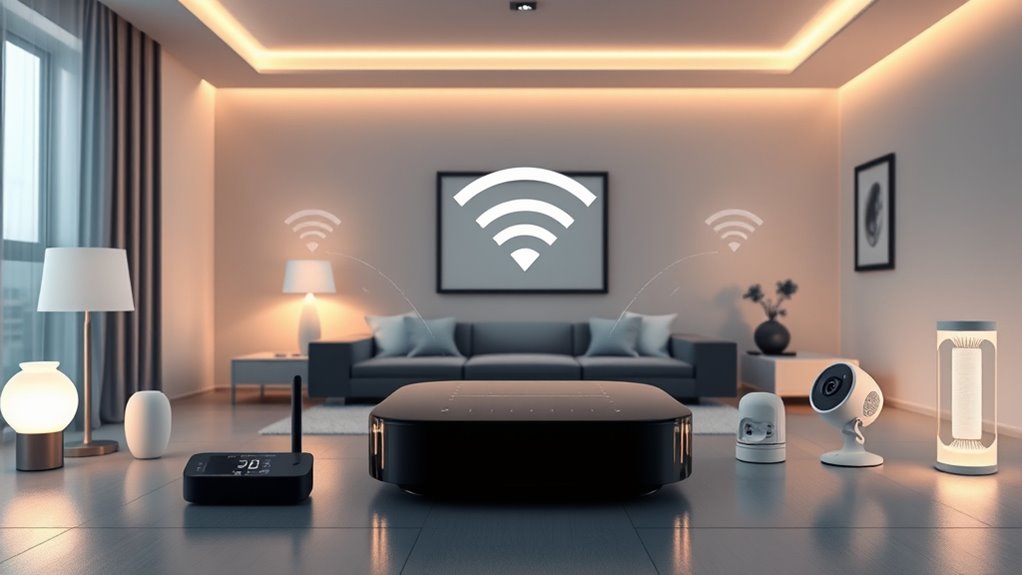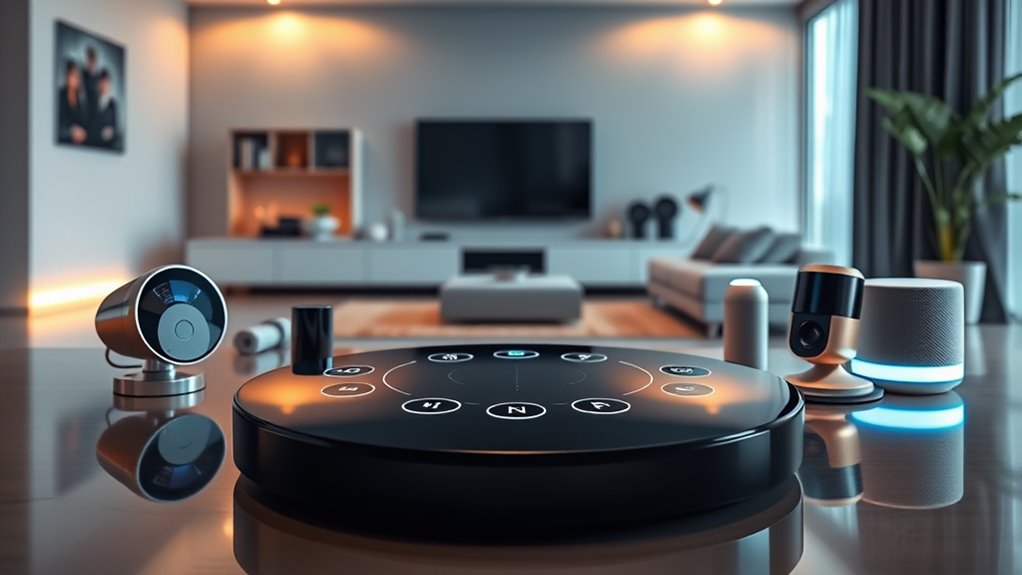If you’re looking for the best premium smart home hubs of 2025, I recommend checking out options like the Homey Bridge, SmartThings Hub, and Philips Hue Bridge, which support multiple protocols like Z-Wave, Zigbee, Wi-Fi, and Matter. These hubs guarantee seamless connectivity across over 100 compatible devices and ecosystems like Alexa, Apple, and Google. They also offer robust security and flexible automation features. Keep exploring, and you’ll discover more about these top choices for your smart home setup.
Key Takeaways
- Compatibility with multiple protocols (Z-Wave, Zigbee, Wi-Fi, Bluetooth, Matter) ensures seamless integration with over 100 smart home devices.
- Advanced automation features enable complex routines, multi-room setups, and quick local processing for reliable control.
- Multiple connectivity options, including Ethernet, dual-band Wi-Fi, and future-proof standards, support stable, scalable smart home ecosystems.
- User-friendly setup, security features, and privacy controls prioritize ease of use and data protection for premium users.
- Ecosystem support with popular voice assistants and ongoing protocol updates guarantees long-term, seamless connectivity.
Homey Bridge Smart Home Hub for Automation
If you’re looking for a smart home hub that offers seamless automation and broad device compatibility, the Homey Bridge is an excellent choice. It supports Z-Wave Plus, Zigbee, Wi-Fi, BLE, and Infrared, connecting with devices from top brands like Philips Hue, Sonos, Nest, and IKEA. The hub allows you to create custom routines and automate actions using the Homey app, giving you complete control over your smart home. Plus, it integrates with voice assistants such as Alexa and Google Assistant, enabling voice commands for Infrared, Zigbee, and Z-Wave devices. Privacy is a priority, ensuring your data stays protected.
Best For: homeowners seeking a versatile, privacy-focused smart home hub that integrates a wide range of devices and offers customizable automation.
Pros:
- Supports multiple connectivity protocols including Z-Wave Plus, Zigbee, Wi-Fi, BLE, and Infrared for broad device compatibility
- Enables easy creation of custom routines and automation via the intuitive Homey app
- Integrates seamlessly with voice assistants like Alexa and Google Assistant for hands-free control
Cons:
- Requires a Homey Premium subscription ($2.99/month) for connecting more than five devices after the free trial
- Compatibility verification for specific devices must be done through the Homey App Store on the official website
- Some features, such as voice control of Infrared devices, may require separate voice assistant purchases or integrations
SmartThings Hub 3rd Generation Home Automation Hub
Looking to unify your smart home devices with a reliable, versatile hub? The SmartThings Hub 3rd Generation is an excellent choice. It supports Alexa, Google Home, Zigbee, Z-Wave, and cloud-to-cloud protocols, making it compatible with a wide range of devices. I love how it consolidates control through a single app, giving me easy monitoring and management. Its automation features allow me to set routines based on door status, occupancy, or other triggers, enhancing convenience and security. The sleek white design fits seamlessly into my home, and its robust compatibility guarantees I can expand my smart ecosystem effortlessly.
Best For: homeowners seeking a reliable, versatile hub to unify and automate a wide range of smart home devices seamlessly.
Pros:
- Supports multiple protocols including Zigbee, Z-Wave, Alexa, and Google Home for broad compatibility.
- Centralized control via a single app simplifies monitoring and management of smart devices.
- Enables custom automation routines based on triggers like door status or occupancy for enhanced convenience and security.
Cons:
- May require some technical setup for optimal integration and automation customization.
- Limited to compatible devices; incompatible or unsupported devices may not work through the hub.
- Firmware updates or app changes could temporarily affect functionality or compatibility.
ecobee Smart Thermostat Premium with Sensors and Air Quality Monitor
The ecobee Smart Thermostat Premium stands out as the ideal choice for homeowners seeking thorough energy management combined with advanced air quality monitoring. It can save up to 26% annually on heating and cooling costs, thanks to features like SmartSensor and automatic detection of open windows or doors. Its built-in air quality monitor alerts you to poor air conditions and reminds you to change filters, while the integrated smoke alarm enhances safety. Compatible with most HVAC systems and supporting solar energy, it’s easy to install and control via app, voice, or smart home platforms. With a sleek design and strong user ratings, this thermostat offers both efficiency and peace of mind.
Best For: homeowners looking for a comprehensive energy-efficient thermostat with advanced air quality monitoring and smart home integration.
Pros:
- Saves up to 26% annually on heating and cooling costs, reducing energy bills.
- Built-in air quality monitor and smoke alarm enhance home safety and air comfort.
- Compatible with various HVAC systems and supports voice control through major platforms like Alexa, Google, and Siri.
Cons:
- Regional restrictions may limit location-based features and geofencing capabilities.
- Sensor performance can vary, potentially affecting accuracy in certain environments.
- Setup and installation might be challenging for users unfamiliar with HVAC systems, despite clear instructions.
Echo (4th generation) International Version with Alexa and Smart Home Hub
For those seeking a versatile smart home hub with premium sound and seamless voice control, the Echo (4th generation) International Version stands out. It combines rich, detailed audio with automatic room adaptation, making it perfect for any space. The built-in Zigbee hub simplifies connecting compatible smart devices like lights, locks, and sensors, all controllable via Alexa. With support for popular streaming services and voice commands, it’s an intuitive way to manage entertainment and smart home functions. Plus, privacy features like the Microphone Off button ensure you stay in control. Available in Charcoal, this device offers a sleek design and powerful performance for a connected home.
Best For: those looking for a stylish smart speaker with premium audio, built-in smart home hub, and seamless Alexa voice control for a connected home experience.
Pros:
- Rich, detailed sound with automatic room adaptation for optimal audio quality
- Built-in Zigbee hub simplifies smart device setup and management
- Privacy features like Microphone Off button enhance user control and security
Cons:
- Some Alexa features like Amazon Kids and Guard may not be supported in all countries
- Streaming services like Amazon Music Unlimited are not available in all regions such as PH, MY, TW
- Limited color options, currently only available in Charcoal
Sengled Smart Home Device, Alexa & Google Assistant Compatible
If you want a reliable smart home hub that seamlessly integrates with Alexa and Google Assistant, Sengled’s Smart Hub is a strong choice. It controls up to 64 Sengled devices, making managing your smart home straightforward. Setup is simple—connect the hub to your router via Ethernet, then follow the in-app instructions. While some bulbs may face pairing or range issues, smart plugs are reliable and easy to install. Once connected, Sengled products respond quickly and work smoothly with voice commands and automation platforms like SmartThings and IFTTT. Overall, Sengled offers an affordable, compatible solution, but proper placement and network setup are key to ideal performance.
Best For: home automation enthusiasts seeking a compatible, easy-to-use hub that integrates seamlessly with Alexa and Google Assistant for managing multiple Sengled devices.
Pros:
- Supports up to 64 Sengled devices for comprehensive smart home control
- Simple setup via Ethernet connection with clear in-app instructions
- Compatible with popular platforms like SmartThings, IFTTT, and voice assistants
Cons:
- Range issues with bulbs may cause pairing and connectivity problems
- Some users find the hub and bulbs relatively expensive for their features
- Limited wireless range of the hub can impact device performance if not properly placed
Kasa Smart Plug HS103P4, Wi-Fi Outlet 4-Pack
Anyone looking to expand their smart home without investing in a central hub will find the Kasa Smart Plug HS103P4 a perfect choice, thanks to its Wi-Fi connectivity and compatibility with Alexa, Google Home, and IFTTT. This 4-pack allows me to control multiple devices remotely via the Kasa app, schedule timers, and automate routines easily. Its UL certification guarantees safety, and setup is straightforward—just plug in and connect through my Wi-Fi network. With support for Android and iOS devices, I can manage my appliances from anywhere. It’s a reliable, user-friendly solution perfect for adding automation without the complexity of a hub.
Best For: those seeking an easy, hub-free way to remotely control and automate multiple home devices with Wi-Fi connectivity and voice assistant compatibility.
Pros:
- Easy setup with no hub required, just plug and connect via Wi-Fi
- Compatible with Alexa, Google Assistant, and IFTTT for hands-free control
- Includes four outlets in a pack, ideal for expanding smart home automation
Cons:
- Requires a stable 2.4GHz Wi-Fi connection for optimal performance
- Limited to 15 amps, which may not support high-power appliances
- Does not include physical switches, relying solely on app or voice commands
Hubitat Elevation Home Automation Hub (Model C-8)
The Hubitat Elevation Home Automation Hub (Model C-8) stands out as an ideal choice for tech-savvy users who prioritize local processing and seamless device integration. It supports Zigbee, Z-Wave, Matter, Wi-Fi, and Ethernet, making it compatible with over 1,000 devices from more than 100 brands, including Apple HomeKit, Alexa, Google, Hue, and Ecobee. Its small, lightweight design includes essential cables and offers fast, reliable automation processing locally, ensuring instant responses even during internet outages. Despite some usability challenges, the hub delivers impressive performance, extensive customization options, and a strong community support network, making it a top premium choice for advanced smart home setups.
Best For: Tech-savvy smart home enthusiasts seeking a reliable, locally processed hub with extensive device compatibility and advanced automation capabilities.
Pros:
- Supports multiple protocols including Zigbee, Z-Wave, Matter, Wi-Fi, and Ethernet for broad device integration
- Local processing ensures fast, reliable automation responses even during internet outages
- Compatibility with over 1,000 devices from more than 100 brands, including major ecosystems like Apple HomeKit, Alexa, and Google
Cons:
- User interface can be non-intuitive and challenging for beginners
- Stability issues reported, especially with Z-Wave device connections and firmware updates
- Steep learning curve and occasional bugs in automation scripting and device management
Echo (4th gen) International Version with Alexa and Smart Home Hub
For smart home enthusiasts seeking a seamless voice-controlled hub, the Echo (4th gen) International Version with Alexa stands out with its built-in Zigbee support and rich audio quality. Its sleek, modern design in charcoal blends well with home decor, and it delivers impressive sound from a 3.0” woofer plus two tweeters, offering clear highs, mids, and deep bass. Connectivity includes dual-band Wi-Fi and Bluetooth for streaming and device pairing. With Alexa’s voice control, you can manage smart devices, play music, and get updates easily. Privacy features like the Microphone Off button add peace of mind, making it a versatile, stylish hub for any smart home.
Best For: smart home enthusiasts who want a stylish, high-quality voice-controlled hub with rich audio and integrated Zigbee support.
Pros:
- Elegant, modern design that seamlessly fits into home decor
- Excellent sound quality with a powerful woofer and detailed tweeters
- Built-in Zigbee hub simplifies smart device setup and management
Cons:
- Plastic back panel may look cheap or feel less premium
- Limited instructions for some functions like adding songs to favorites
- Regional restrictions may limit Alexa skills and language options outside US and Europe
Lockin Wi-Fi Gateway and Electronic Lock Component for Smart Lock Control
If you’re looking for a reliable way to control your smart locks remotely, the Lockin Wi-Fi Gateway is an ideal choice. It supports various devices like Q3/Q1 Smart Door Knob and L1 Smart Box, ensuring seamless connectivity. Setup is quick—just plug it in and connect via the app in under two minutes, with a recommended distance of under 10 feet for stability. You can remotely lock or access doors, manage access codes, and monitor lock status from anywhere. The gateway also provides real-time activity logs and battery alerts, boosting your home security and giving you peace of mind with reliable, remote control.
Best For: homeowners and property managers seeking reliable, remote control of multiple smart locks with easy setup and enhanced security.
Pros:
- Supports a variety of smart lock models including Q3/Q1 Smart Door Knob and L1 Smart Box for versatile use
- Quick and simple installation within two minutes, with stable connectivity under 10 feet
- Enables remote lock control, access management, and real-time security monitoring from anywhere
Cons:
- Not compatible with Lockin Veno series locks, limiting device options for some users
- Requires a Wi-Fi connection, which may be less effective in areas with poor internet stability
- The recommended setup distance may restrict flexibility in larger or multi-story properties
Kasa Smart Light Switch HS200, Single Pole, Wi-Fi Light Switch
Anyone looking to upgrade their home lighting with a reliable, hub-free solution will appreciate the Kasa Smart Light Switch HS200. This single-pole, UL-certified switch connects directly to your Wi-Fi network on the 2.4 GHz band, requiring no hub or complex setup. With the Kasa or Tapo app, installation is straightforward, especially if you have neutral wiring. Once installed, you can control your lights remotely, set schedules, or activate voice commands via Alexa or Google Assistant. Trusted by over 4 million users, the HS200 offers dependable performance, security features, and seamless integration, making it a smart choice for modern home automation.
Best For: homeowners seeking a reliable, easy-to-install smart light switch that works without a hub and integrates seamlessly with voice assistants.
Pros:
- No hub required; connects directly to your Wi-Fi network for easy setup
- Compatible with Alexa and Google Assistant for hands-free control
- Supports scheduling and security features like ‘away mode’ for added convenience and safety
Cons:
- Requires neutral wiring, which may not be available in all homes
- Only works with 2.4 GHz Wi-Fi networks, not 5 GHz
- Limited to single-pole installation, not suitable for multi-way switches
Orbit 21006 B-hyve Wi-Fi Hub, Gray
Looking to upgrade your outdoor watering system with seamless Wi-Fi control? The Orbit 21006 B-hyve Wi-Fi Hub in gray is just what you need. It’s compatible only with select B-hyve hose faucet timers, turning Bluetooth devices into Wi-Fi-enabled controllers. This hub allows you to manage your watering schedule remotely via your Wi-Fi network, making outdoor irrigation effortless. It comes with a wall adapter and is designed for indoor use, ensuring protection from the elements. Keep in mind, it’s ideal for specific B-hyve models and enhances their functionality with Wi-Fi connectivity. If you want smarter watering, this hub is a solid choice.
Best For: homeowners and gardeners seeking to upgrade their outdoor watering systems with remote Wi-Fi control for select B-hyve hose faucet timers.
Pros:
- Enables remote management and scheduling of watering via Wi-Fi for compatible B-hyve devices.
- Easy to install with included wall adapter; designed for indoor use, protecting the device from outdoor elements.
- Enhances existing Bluetooth-based irrigation controllers with Wi-Fi functionality, adding convenience and automation.
Cons:
- Compatibility limited to specific B-hyve models (No. 21004 and No. 21005), restricting its use with other devices.
- Requires a Wi-Fi connection and indoor installation, not suitable for outdoor or unprotected environments.
- Does not include the B-hyve hose faucet timers itself; it only adds Wi-Fi capabilities to compatible devices.
SABRENT 60W 6-Port USB Desktop Charger (AX-FLCH-B)
The SABRENT 60W 6-Port USB Desktop Charger (AX-FLCH-B) is an ideal choice for households that need to charge multiple devices simultaneously without sacrificing speed or safety. With a total output of 60 watts and six ports, it delivers up to 2.4 amps per port, supporting rapid charging for smartphones, tablets, and other USB devices. Its aluminum construction ensures durability, while smart technology optimizes power distribution. Compatible worldwide with AC 110-220V, it’s perfect for international travel. Safety features like overcharge protection keep your devices secure. Plus, the one-year warranty offers peace of mind, making it a reliable addition to any smart home setup.
Best For: households and travelers needing to charge multiple USB devices quickly and safely at home or abroad.
Pros:
- Provides rapid charging with a total of 60W (12A) across six ports, each delivering up to 2.4A.
- Durable aluminum construction combined with smart technology for efficient power distribution.
- Compatible with a wide range of devices and supports international voltage (110-220V), ideal for travel.
Cons:
- May be bulky compared to single-port chargers, taking up more desk space.
- No individual port power indicators, making it harder to monitor charging status per device.
- Limited to USB charging, so it cannot power non-USB devices or fast-charging standards beyond 2.4A per port.
Aluminum Tilt & Swivel Stand for Ech_ooo Hub
The Aluminum Tilt & Swivel Stand for Ech_ooo Hub is designed for users who want versatile and secure support for their smart home hub. Made from high-quality aluminum alloy, it offers durability and a sleek modern look that complements any decor. Its 360° rotation and adjustable tilt let me customize viewing angles for video calls, streaming, or recipes. The open design maintains clear sound quality, while the anti-slip silicone pads and locking mechanism keep the hub stable and protected. Easy to install without tools, it fits on desks, countertops, or shelves, enhancing my smart setup with stability and style. It’s a reliable, functional accessory for daily use.
Best For: users seeking a sleek, versatile, and stable stand to enhance their Ech_ooo Hub’s functionality in various home or office environments.
Pros:
- Durable construction with high-quality aluminum alloy for long-lasting use
- 360° rotation and adjustable tilt for customizable viewing angles
- Open design ensures clear sound quality and easy access to device controls
Cons:
- Higher price point compared to basic stands may be a consideration for budget-conscious buyers
- Limited to compatibility with Ech_ooo Hub, not suitable for other devices
- Slightly heavier weight (8.1 ounces) may be less ideal for very portable setups
Echo (4th Gen) Smart Speaker with Alexa, Charcoal
If you’re seeking a smart speaker that seamlessly integrates with your smart home, the Echo (4th Gen) Smart Speaker with Alexa is an excellent choice, especially since it includes a built-in Zigbee hub. It offers premium sound with clear highs, dynamic mids, and deep bass that adapt automatically to your room. The device supports dual-band Wi-Fi and Bluetooth for streaming and device control. Plus, its smart home capabilities let you control compatible lights, locks, and sensors with just your voice. Compact yet powerful, it’s designed for easy setup and reliable performance, making it a versatile hub for your connected home in 2025.
Best For: smart home enthusiasts seeking a versatile, high-quality speaker with built-in Zigbee hub for seamless device integration and voice control.
Pros:
- Premium sound quality with adaptive highs, mids, and bass
- Built-in Zigbee hub for easy smart home device integration
- Supports dual-band Wi-Fi and Bluetooth for versatile streaming and control
Cons:
- Some Alexa features may be limited or unavailable in certain countries
- No support for Bluetooth speakers requiring PIN codes
- Larger size may be less suitable for very compact spaces
Philips Hue Bridge, Smart Lighting Hub
Are you looking for a reliable way to control multiple smart lights seamlessly? The Philips Hue Bridge is my go-to solution. It unblocks full system capabilities like automations, remote access, multi-room setups, zones, and compatibility with voice assistants and Matter. Using Zigbee technology, it offers a secure, stable connection that reduces Wi-Fi strain and keeps lights functioning during outages. You can control up to 50 lights and accessories indoors and outdoors, and manage everything remotely via the Hue app. Plus, it supports surround lighting that syncs with movies, music, and games, making your entertainment truly immersive.
Best For: homeowners and tech enthusiasts seeking a reliable, expandable smart lighting system with seamless control and entertainment integration.
Pros:
- Secure and stable Zigbee connection minimizes Wi-Fi strain and maintains functionality during outages
- Supports controlling up to 50 lights and accessories both indoors and outdoors
- Compatible with voice assistants, Matter, and supports immersive surround lighting for media
Cons:
- Requires additional hardware like HDMI Sync Box for media synchronization features
- Setup and configuration may be complex for beginners unfamiliar with smart home systems
- Limited to 50 lights and accessories, which might be restrictive for very large installations
Factors to Consider When Choosing Premium Smart Home Hubs

When choosing a premium smart home hub, I consider how well it works with my existing devices and the connectivity protocols it supports. I also look at its automation capabilities, privacy features, and how easy it is to install. These factors help guarantee I pick a hub that’s reliable, flexible, and secure for my smart home.
Compatibility With Devices
Choosing the right premium smart home hub hinges on its ability to seamlessly communicate with your existing devices. I look for a hub that supports the communication protocols my devices use, like Z-Wave, Zigbee, Wi-Fi, or Bluetooth, to guarantee smooth integration. It’s crucial to verify that the hub is compatible with the brands and models I already own, preventing connectivity hiccups. I also consider whether the hub works with popular voice assistants like Alexa, Google Assistant, or Apple HomeKit, enabling easy voice control. Additionally, I check if it supports the latest standards such as Matter, which improves interoperability across ecosystems. Finally, I confirm the hub can connect via Ethernet or Wi-Fi and handle the number of devices I plan to automate, supporting scalable, reliable connectivity.
Connectivity Protocols Offered
Ever wondered which connectivity protocols are essential for a premium smart home hub? The best hubs support multiple protocols like Z-Wave Plus, Zigbee, Wi-Fi, BLE, and Infrared, guaranteeing compatibility with a wide range of devices. Z-Wave and Zigbee are vital for local control, providing reliable communication without relying on cloud services. Wi-Fi connectivity offers direct integration with your home network, making setup and control via smartphone apps straightforward. Bluetooth Low Energy (BLE) is ideal for short-range communication with sensors, wearables, and accessories, enabling seamless automation. Some advanced hubs now include support for emerging standards like Matter, which promises interoperability across different ecosystems and future-proofing your smart home setup. These protocols collectively guarantee a flexible, reliable, and scalable smart home experience.
Automation and Customization
A smart home hub’s true power lies in its automation and customization features, allowing users to tailor their environment to their specific needs. Advanced automation capabilities enable creating complex routines with multiple triggers and actions, making daily tasks effortless. Customization options such as personalized device scenes, user profiles, and voice command configurations enhance the user experience. Support for local processing ensures automations respond quickly and reliably, reducing dependence on cloud services. Compatibility with protocols like Zigbee, Z-Wave, and Matter offers flexibility, integrating diverse devices seamlessly. An intuitive interface with graphical editors, scripting tools, or rule-building features simplifies setup and management. These elements together make a premium hub truly adaptable, empowering users to craft a smart home environment that’s both efficient and personalized.
Privacy and Security Features
When selecting a premium smart home hub, prioritizing privacy and security features is essential to protect your personal data and maintain control over your environment. I look for hubs that follow privacy-by-design principles, ensuring my data isn’t collected, profiled, or shared without my explicit consent. Physical privacy controls, like microphone mute buttons and disable switches, give me confidence that unauthorized voice activation is prevented. Secure encryption protocols are a must to protect data during transmission and device pairing, reducing hacking risks. Regular firmware updates are crucial, as they patch vulnerabilities and improve privacy features over time. Clear privacy policies and user-controlled settings allow me to manage data sharing, device access, and automation permissions effectively, ensuring my smart home remains secure and private.
Ease of Installation
Choosing a premium smart home hub becomes much easier when it offers clear, step-by-step setup instructions that guide me through the installation process. I look for hubs that are compatible with various environments, whether I want to wall-mount or place them on a table, to make setup simple. Features like included mounting hardware, tool-free assembly, or quick-connect cables help me avoid extra tools and complicated wiring. A user-friendly mobile app or interface that walks me through each step minimizes technical difficulties. Additionally, support resources such as detailed manuals, video tutorials, or responsive customer service make installation smoother and less stressful. When a hub simplifies setup, I can start enjoying my smart home faster and with less frustration.
Ecosystem Integration
Supporting multiple protocols like Zigbee, Z-Wave, and Matter is crucial because it guarantees my hub can communicate with a wide range of devices from different ecosystems. This flexibility ensures I’m not limited by proprietary standards, making my setup more versatile. Seamless integration with voice assistants such as Alexa, Google Assistant, and Apple HomeKit simplifies control, allowing me to manage everything with just my voice. Compatibility across various platforms and ecosystems means I can centralize control and automate devices from different manufacturers effortlessly. Open APIs and standard communication protocols further expand my ecosystem’s capabilities by enabling third-party device integration. Regular firmware updates are essential to keep the system compatible with new standards and devices, ensuring my smart home remains future-proof and reliable.
Frequently Asked Questions
How Do Smart Home Hubs Ensure Secure Device Communication?
Smart home hubs keep device communication secure by using encryption protocols like TLS and WPA2, which protect data from eavesdropping. I also guarantee my hub regularly updates its firmware, closing security loopholes. Additionally, I set strong, unique passwords and enable two-factor authentication when possible. These measures help prevent unauthorized access, giving me peace of mind that my smart devices communicate safely and securely.
Can Multiple Hubs Be Integrated for Expanded Coverage?
Absolutely, multiple hubs can be integrated to expand coverage. I’ve found that many premium hubs support seamless multi-hub setups, creating a more reliable and extensive smart home network. By linking different hubs, I’ve managed to cover larger areas and improve device communication. Just make sure they’re compatible and properly configured, and you’ll enjoy a smooth, interconnected smart home experience that’s both flexible and robust.
What Is the Typical Setup Process for New Smart Hubs?
Setting up a new smart hub is straightforward. First, I connect it to power and my Wi-Fi network. Then, I download the hub’s app on my smartphone. The app guides me through the setup, including creating an account and pairing devices. I follow prompts to customize settings, link smart devices, and guarantee everything’s connected properly. It usually takes about 10-15 minutes to get everything up and running smoothly.
How Do Hubs Handle Firmware Updates and Security Patches?
Think of firmware updates like a superhero’s power boost—hubs handle them automatically, ensuring your device stays sharp. They periodically check for security patches, often overnight, so your network remains protected without interruption. I find this seamless process reassuring, as it’s like having a vigilant guardian constantly working behind the scenes. Rest assured, these updates keep your smart home safe, efficient, and always up-to-date without you lifting a finger.
Are There Compatibility Differences Between International and Regional Versions?
Yes, there are compatibility differences between international and regional versions of smart home hubs. I’ve found that regional models often include localized language options, power adapters, and specific frequency support, which can influence connectivity and device compatibility. It’s essential to select the version suited for your region to ensure smooth operation and avoid issues with updates or device pairing. Always check regional specifications before purchasing.
Conclusion
Did you know that the global smart home market is projected to reach $174 billion by 2025? Choosing the right premium hub can truly transform your connected living experience. Whether it’s seamless automation, voice control, or smart lighting, these options offer unmatched convenience and sophistication. Investing in a top-tier hub guarantees your devices work harmoniously, making everyday life simpler and more enjoyable. Let’s make your home smarter, one connection at a time.





![SmartThings Hub 3rd Generation [GP-U999SJVLGDA] Smart Home Automation Hub Home](https://m.media-amazon.com/images/I/21hChu0ounL._SL500_.jpg)


















